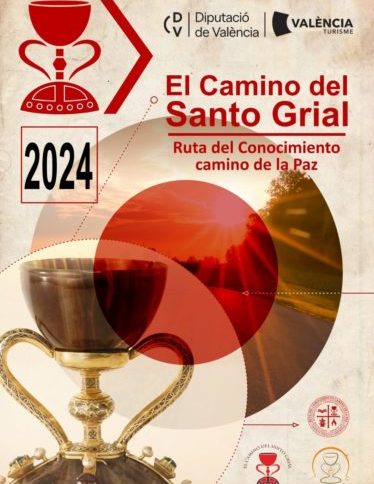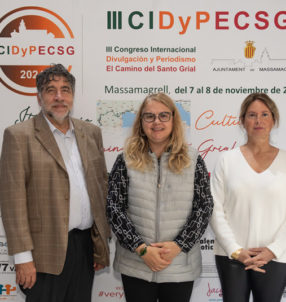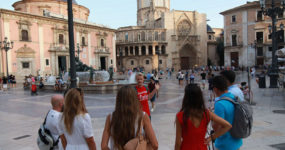It will work on the basis of solidarity to create links and human values among those who wish to come and discover Valencia. The Provincial Council of Valencia, through its deputy Pedro Cuesta, in charge of managing the area of Tourism and responsible for Turisme València, has approved the granting of aid to the ‘Asociación Cultural El Camino del Santo Grial’. This collaboration is allowing the realization of a comprehensive audit of the Valencian section of the Way of the Holy Grail, with the aim of laying the foundations for a future signage that enhances this cultural and tourist itinerary.
The audit will cover from Algar del Palancia to Alboraya, including key towns such as Sagunto, El Puig de Santa María and Massamagrell, among others. This work aims to identify the route, in order to work on opportunities for improvement and to increase its cultural and tourist attractiveness.
The Asociación Cultural El Camino del Santo Grial has for this task with the collaboration of Alejandro Martínez Notte and Cristina Monzón, recognized specialists of the broadcasting channel Teleaire.com. Both have travelled this historic route on foot, documenting each section with meticulousness and rigour, thus providing valuable material for this project.
The results of the audit, together with a proposal for signposting, will soon be presented to the Diputación de Valencia. But there are also plans to publicise all this work in one of the municipalities that form part of the Way of the Holy Grail.
This project reinforces the commitment of the Diputación de Valencia and Turisme València to the preservation and promotion of the province’s cultural and heritage resources.
Dr. Ana Mafé, president of the ACECSG comments that “this initiative consolidates the Way of the Holy Grail as a cultural and spiritual reference, not only for the province of Valencia, but also as an axis of connection with European heritage”.
ALGAR DE PALANCIA
Small and picturesque, Algar de Palancia combines the charm of its historic centre with the serenity of its natural surroundings. This municipality invites pilgrims to reflect on their journey, enveloped by the tranquillity of its cobbled streets and the murmur of the river Palancia, which has witnessed the passage of time and the stories of faith and devotion that the Way of the Holy Grail embodies.
ALGIMIA DE ALFARA
With a rich agricultural heritage and tranquil surroundings, Algimia de Alfara offers the walker a moment of peace and contemplation. Its parish church and nearby landscapes inspire a connection with the divine and the earthly, reminding the pilgrim that each stage is an opportunity to reconnect with oneself.
TORRES TORRES
The Arab legacy resounds in Torres Torres, whose perfectly preserved Muslim tower is a historical beacon for travellers. This enclave represents the meeting of cultures that have shaped the Way of the Holy Grail, uniting past and present in a poetic dialogue of spirituality and heritage.
ESTIVELLA
Located at the foot of the Sierra Calderona mountain range, Estivella is a natural refuge for the walker. Its local traditions and mountainous landscapes reinforce the spirit of the pilgrim, while its church and natural springs recall the importance of water as a symbol of purification on the sacred journey.
ALBALAT DELS TARONCHERS
Surrounded by orange groves, this municipality reflects the fertility of the land and the generosity of its people. Its simple architecture and green fields invite the walker to a contemplative pause, evoking the spiritual richness that the Way of the Holy Grail seeks to transmit.
SAGUNTO
The historic city of Sagunto stands out for its Roman theatre and castle, witnesses to centuries of civilisation and faith. As a crucial stop on the Way, Sagunto is a living reminder of shared history, where the spiritual and the cultural converge to enrich the spirit of the pilgrim.
PORT OF SAGUNTO – MARSHES OF THE MORO
Puerto de Sagunto, with its industrial heritage and the nearby Marjal del Moro, offers a contrast between modernity and unspoilt nature. Here, the traveller experiences the transition between human bustle and the tranquillity of the wetlands, a space for reflection on the way to the sacred.
PUÇOL
Puçol combines its agricultural tradition with modern growth. Its proximity to the sea and its historical legacy make this municipality a place of connection with nature and the past, reinforcing the introspective character of the Way of the Holy Grail.
EL PUIG DE SANTA MARÍA
The Monastery of El Puig de Santa María is an icon of Valencian heritage and a spiritual beacon for pilgrims. This place, full of religious symbolism, provides a place for prayer and meditation on the way to Valencia.
LA PUEBLA DE FARNALS
Its proximity to the sea and the simplicity of its daily life make La Puebla de Farnals an ideal place to connect with the essence of the Camino. Its marine landscapes and its hospitality remind the traveller of the importance of calmness in the spiritual journey.
MASSAMAGRELL
Known for its link to the Camino de Santiago, Massamagrell connects the spirit of two great pilgrimage routes. Its streets are home to a cultural heritage that inspires pilgrims to continue their journey with renewed hope and faith.
EMPERADOR
The smallest municipality in Spain, Emperador symbolises the humility and grandeur of the small. In this corner, the traveller finds a moment to appreciate the simple things, essential in every journey of inner growth.
ALBALAT DELS SORELLS
Rich in history and traditions, Albalat dels Sorells stands out for its medieval castle and its welcoming environment. Here, the past intertwines with the present, offering the pilgrim a tangible connection with the history of the Camino.
MELIANA
Meliana, with its orchards and modernist architecture, provides a unique contrast on the Camino. This municipality celebrates the connection with the land and art, reminding the traveller that the spiritual journey is also an act of creativity.
ALBORAYA
Famous for its horchata and tiger nut fields, Alboraya is an example of how tradition and innovation coexist in harmony. Its agricultural essence and its proximity to Valencia make this stop a bridge between the rural and the urban on the Way of the Holy Grail.
VALENCIA
The route culminates in the imposing Valencia Cathedral, where the Holy Chalice awaits pilgrims. This spiritual and cultural epicentre reflects the heart of the Camino, a place where faith, history and art intertwine in a universal message of hope and transcendence.
The signposting of the Way of the Holy Grail in the province of Valencia is fundamental to consolidate this cultural itinerary as a reference point for the connection between history, spirituality and tourism. This route, which links Somport in Huesca with the GR258 as an international representation in Europe, not only unites geographies, but also symbolises the Route of Knowledge and the Way of Peace.
Signposting it reinforces its identity, facilitates the transit of pilgrims and promotes its value as a cultural and spiritual axis that transcends borders. It also guarantees the preservation of its legacy, promotes the sustainable development of the communities along it and enhances its attractiveness as a strategic tourist resource on the international scene.
Report by Will McCarthy
Article copyright ‘24/7 Valencia’
Related Post
This site uses Akismet to reduce spam. Learn how your comment data is processed.
























Leave a comment